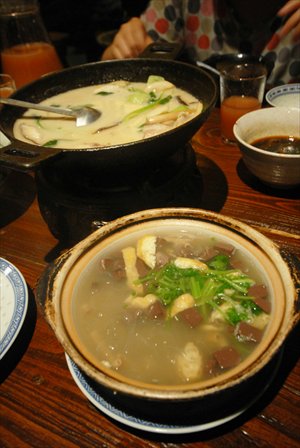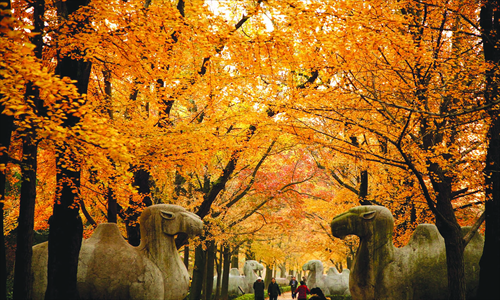Naturally Nanjing




When a city became the political center, ancient Chinese would call it "jing," which means capital. In China's 5,000 years history, countless cities became "jing" as dynasties rose, but the label faded as quickly as dynasties fell. Today only two cities still own the glorious title: Beijing and Nanjing.
Nanjing literally means southern capital, while Beijing means northern capital. Nanjing, which is the capital of Jiangsu Province and lies in the lower basin of the Yangtze River, shares many features in common with its northern counterpart: a rich historical heritage, a respect for culture, lots of entertainment and tasty food. The biggest differences are that Nanjing has more natural scenery and is more laid back.
Few cities around the world dare call themselves a nature park. But if Nanjing is not, then it is not far from one. When most people arrive in Nanjing, they are shocked by its color: green. Yes, Nanjing is green. It has a green coverage of 41.2 percent in the city and innumerable plants in every corner. Gigantic platanus trees stand alongside all its major avenues, offering emerald color from spring to early autumn, while its lawns are freshly green for most of the year.
The Zijin Mountain, or Purple Gold Mountain, in east Nanjing, is its most forested zone, a 400-meter tall natural oxygen generator and humidifier which spans 20-square kilometers. No matter if you are a fan of walking, jogging or cycling, go to the mountain at dawn or dusk. There you may witness how sunshine casts upon the thick layer of forests and reflects on a mysterious purple and golden mist.
Best season to visit
Spring is the most fragrant season for Zijin Mountain. That's because of its southern part, which is called Meihua Shan, literally meaning "the mountain of plum blossoms." Spanning an area of 102 hectares, more than 13,000 plum trees of 400 different spices are planted here. Some are unique to the area. For this reason it is recognized as China's largest plum blossom garden. Every February a huge plum blossom festival is held here.
During summer, visit Xuanwu Lake in the central-northeast part of the city. Every day it offers cool, moist breezes and the fresh smell of lotus flower if you come in the right season. Even if you missed the lotus, climb on the nearby city walls made in the Ming Dynasty and watch the lake and the slim, green willows dance in the setting sun.
For autumn, the Qixia Mountain is a must-see. The mountain, which is located on the far east side of the city, has been thoroughly planted with maples. November is a wonderful time to visit there, the rich color of flaming red and sun-set gold may give you an illusion of evening glow.
Nanjingers have a deep affection for their trees. They live with the trees and share the benefits from the trees. Some still remember the leafy walks of tall plane trees even after they've been away for years and would proudly tell you that the city has "world's best boulevard."
Memories of yesterday
Nanjing twice served as national capital, during the Ming Dynasty (1368-1644) and the Republic of China period in the early 20th Century. It also functioned as capital of eight different regional regimes since the city was first built in 472 BC. The frequent shift of political power has left a significant impact on Nanjing: it has been officially given more than 40 different names.
Unlike Beijing, which still has many preserved relics, most of Nanjing's relics were destroyed by riots, foreign invasions and the Culture Revolution. The remaining buildings in Nanjing were mostly constructed during the Ming Dynasty and the Republic of China, among which the Ming Xiaoling Mausoleum and Dr Sun Yatsen's Mausoleum are the places you should not miss.
Both mausoleums are located on Zijin Mountain. The Ming Xiaoling Mausoleum was built in the Ming Dynasty. It is the tomb for its first emperor Zhu Yuanzhang. Zhu is the first and only emperor of the Ming dynasty who was buried outside of Beijing, and the building style of Ming Xiaoling influenced all the other imperial tombs of the Ming dynasty.
The tomb has a 600-meter long stone avenue, with stone lions, camels, elephants and horses standing by its sides, which were supposed to guard the tomb. They were crafted in a detailed and solemn way, and have stood 700 years without changing much. When autumn comes, the avenue is decorated with golden and red leaves, adding a beauty of stillness.
Dr Sun Yat-sen's Mausoleum is located much higher up the slopes than Ming Xiaoling. Sun has a high reputation in Chinese history as he is widely recognized as the father of modern China. When the Republic of China was first founded in Nanjing, Sun expressed his desire to be buried in Zijin Mountain. Thus when Sun passed away in 1925, the ruling Kuomintang party built the tomb for him here.
The mausoleum spans more than 3,000 hectares, and is shaped like an alarm bell from a bird's-eye view, as it was built to memorize Sun's political last wish of waking Chinese people up. Its buildings were constructed with white marble and blue-gazed tile, and carved with large chrysanthemum paints.
Nanjing's own taste
Being one of the metropolises of the Yangtze Delta, Nanjing is often compared with Shanghai. And being one of the only two "jings," Nanjing is often compared with Beijing. But if you have been to these three cities, you will find the Nanjing has its own pace.
Food offers some of the most obvious proof of Nanjing's uniqueness. Though Nanjing is traditionally classified as one of the Jiangnan cities (cities south to the Yangtze River, whose food is famously, or notoriously for some people, known for using lots of sugar), its food actually combines the advantages of most cooking styles in China, which are neither too sweet, nor too salty.
Nanjingers love eating ducks. Their most famous food, yaxue fensi soup, is made with fresh duck blood, noodle made from green bean and boiled with duck meat and bone. It has a fresh, jelly-like texture, and lasting aftertaste.
Few people know the world-famous Beijing roast duck was actually an adopted version from Nanjingers. A legend says when the third emperor of the Ming Dynasty, Zhu Di (1360-1424) shifted the capital from Nanjing to Beijing, he brought lots of duck roasters to the new capital. But Nanjingers won't slice roast ducks into slim pieces. On the contrary, ducks will be cut into larger chunks to enjoy the crispy skin and rich sauce better.
Salted duck is a typical Nanjing dish. Before being served, the duck will be stewed carefully in salt water with many spices, yet the temperature will be carefully controlled around 90 C. Never letting the pot boil is the key to keeping its soft, juicy texture and refreshing taste.
For dessert lovers, you cannot miss Tangyumiao, or sweet boiled eddoes. Lovely small white eddoes will be thoroughly boiled with brown sugar to make it feels silky on your tongue. Dry osmanthus flower will be also added to make it attractive.
A casual Nanjing life
If you are a bookworm, congratulations, you've come to the right place as Nanjing has probably China's best independent bookshop, Xianfeng Bookshop, or the Libraire Avant-garde. The bookshop, which was founded by a Christian, has a 3,700-square meter floor space in its headquarters (approximately 10 times larger than Danxiangjie Bookshop in Joy City).
Certainly the charm of a bookshop can never be measured by its size, but at least it allows you to wander in the mountains of books.
If you are tired, the bookshop offers some good coffee and comfortable sofas, not to mention the occasional salons, forums and seminars which may help you find people to share your thoughts with.
After spending a whole afternoon in a bookshop, how about going to watch the Kunqu opera for your evening? Jiangsu is the origin place of Kunqu, an opera style which is famous for its graceful dances, delicate costumes and exquisite lyrics. UNESCO listed it as one of the Masterpieces of Oral and Intangible Heritage of Humanity in 2001. Being the capital of Jiangsu, the Jiangsu Kunju Theater offers some of the best Kunqu performances in China.
Want to hang out? Go the 1912 district. It is named after the year Republic of China was founded, and was built in the Republic of China style of gray brick buildings. With all the cafes, bars, and KTV parlors here, most people can find what they like.
Want to shop? The Deji Plaza in the city center offers Hermes, LV, Cartier and Tiffany. If you want some budget choices, you can have a chance to argue and to bargain with shop owners at the Fashion Lady Underground Shopping Mall, which is just across street.
Tips:
Spring and autumn are the best seasons for visiting Nanjing, while early and later summer, when weather is not too hot, is also good. Avoid the mid-summer days, as Nanjing's temperature can reach 40 degrees Celsius.
Yunjin (Nanjing brocade), Yuhua stone (rain flower stone) and gold leaf handicrafts are the best selection of souvenirs. Yunjin is a richly decorated fabric made with silk, gold and silver thread, which can only be made by hand. A skilled tailor can only produce 5 centimeters of Yunjin every day. Yuhua stones are agate stones with a naturally lovely color, which can only be found in Nanjing.